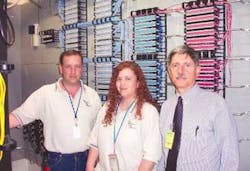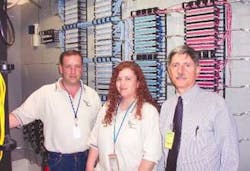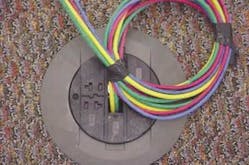Cox Communications (www.cox.com), a Fortune 500 company and the nation's fourth-largest cable television provider, serves approximately 6.5 million customers in 23 states across the country. Like many of its competitors in the communications-service market, Cox is a full-service provider, with offerings that go beyond cable TV to include local and long-distance telephone service, high-speed internet access, and commercial voice and data services.
Cox's New England operations are headquartered in West Warwick, RI, a location from which the company serves Rhode Island and Connecticut. Earlier this year, the company moved into a newly constructed facility in West Warwick, and in the process centralized a number of employees who had been working remotely or in satellite offices in different parts of the state.
null
The building, four stories tall with approximately 85,000 total square feet, is adjacent to the existing West Warwick building that had been serving as the company's New England headquarters. While some operations remain in the original structure, most employees are now housed in the new facility.
Successful by design
Considerations for the design of the building's structured cabling systems began before ground was broken. Edvance Technology Design (www.edvancetech.com), the communications-system design firm for the project, worked closely with representatives from architects Cox, Symmes, Maini & McKee (www.smma.com), the building construction company, office furniture provider, and other concerned trades to ensure the project was designed to meet today's needs and anticipated growth.
Edvance wrote the request-for-proposal (RFP), solicited bids, conducted pre-bid meetings, and made recommendations to Cox. So, to say that Edvance was responsible for "project design" has a double meaning. They designed the communications infrastructure for Cox's new facility, and also took responsibility for directing the installation project itself. For this project, Edvance also provided its construction-administration services, by which it oversaw the project to ensure the cabling work was completed in accordance with applicable Codes, standards, and project-centric specifications. As administrator, Edvance also oversaw change orders. As part of the RFP process, bidders were required to provide fixed unit-cost pricing for each type of Work Area Outlet to be installed. With this information, Cox could better calculate and manage change order costs.
Cox chose cabling-contracting firm New England Line Network, a contractor with which Cox has maintained a working relationship for approximately four years. New England Line Network is based in Pittstown, NJ, with New England offices in Rhode Island and New Hampshire. The company has been installing cable TV infrastructure for a dozen years, and has installed voice and data cabling systems for approximately five years.
null
New England Line's Geoff Nichols, regional network manager, had overall responsibility for the project; Chris Holden, New England Line's project manager, assumed responsibility for day-to-day operations. Tony De Shiro, Edvance's project engineer for the Cox project, says "I couldn't be more satisfied with the quality of work and professionalism of both Geoff and Chris. Their 'can-do' attitude and attention to detail saved me a tremendous amount of time in project management and travel."
De Shiro explains that the specifications he set as both system designer and construction administrator attempted to leave nothing to chance. In many places, the specifications included the three-word, iron-clad phrase, "No substitutions allowed," ensuring that the specific brands and parts specified were, in fact, deployed.
"The specifications don't just say, 'Category 6-compliant,'" De Shiro says. "I included in the specs tables of performance for near-end crosstalk, return loss, as well as characteristics of the voice and fiber backbone cables. That's how I approach all the specifications I write. The goal is to avoid ambiguities so that everyone has a clear definition of what is required."
Meeting diverse needs
As a high-technology communications company, Cox employs professionals with diverse communications needs, from basic telephone and LAN access at workstations to video-intensive applications in demonstration rooms. Additionally, the company's systems communications center (SCS) is a 24×7 operation that manages the outside-plant network by which Cox services its customers. The SCS includes 90 workstations and resides in the existing building, where it will remain.
This diversity of needs required both logical and creative approaches by both the design and installation teams. For example, the 650 workstations on the four floors of the new building all have two data and two voice outlets, and every one of those outlets is color-coded identically. Green and yellow cables support the data links while blue and red cables support the voice links. Each cable is terminated to a jack of the same color.
"The two-data, two-voice color coding will be a Cox standard," says Glenn Dalton, the company's PC/LAN/telecommunications manager. "Anyone who handles the cabling system will not have to be retrained if they go to another facility." The color coding also serves security purposes, by preventing either accidental or intentional connections to inappropriate systems.
The project also included infrastructure for training laboratories. At each workstation in these labs are the four color-coded jacks found at workstations, plus an additional, different-colored port specific to the labs. All cabling infrastructure for the training labs is housed inside its own enclosure in a nearby telecommunications room (TR) so that the training environment remains a separate entity. This is especially important so that the training network does not get inadvertently patched into the corporate network.
"The demo room is a showplace for all of Cox's services to potential customers, which means that it is a fully functional facility with cable TV, dial tone service, and ISP access," says Dalton. "To segregate this facility from the corporate and training networks, a separate technology room was designed with its own horizontal cable color scheme, and voice, data, video and fiber backbone cables."
Workstations in the demo room have one voice connection, two data connections, and one video connection. Because Cox offers residential-networking services and also reaches classrooms, it was important for the demonstration room to simulate these environments as closely as possible. So, the stations within the demo room vary accordingly.
Accessibility and aesthetics
Where poke-thrus were needed, Edvance specified Wiremold RC4 assemblies for both aesthetic and practical reasons. "Poke-thrus are unobtrusive and, depending on the model used, they can support multiple functions," says De Shiro.
"The poke-thrus are nice to work with," comments New England Line Networks' Nichols. "I prefer them over power poles, because they keep you out of the ceilings."
With all of Cox's West Warwick daily operations relocated to the new building, and the "nerve center" SSC remaining in the existing building, it became necessary to redesign the existing main cross-connect (MC) to support the larger network for both buildings. The redesign resulted in an entirely new row of racks in the MC, new overhead cable tray, new voice cross-connect fields, and a new intermediate crossconnect (ICX) field. So as not to interfere with the existing network during the installation, "swing" network switches were relocated to the new racks, and patched to the servers using long optical-fiber patch cords. With this arrangement, the entire data network was cut over to the new station cable with virtually no downtime. Telephone service was maintained by pre-wiring horizontal station cable to the IXC so that as each extension was ready for cut-over, the only thing that had to be done was to install cross-connect wire.
Inside each TR, Edvance's De Shiro specified 20-A twist-lock electrical receptacles to be installed on the underside of the ladder-style cable tray. "With this standard Edvance configuration," De Shiro says, "all power cords from the equipment rack plug in overhead. There are no cords to trip over."
To dress and manage cables, and to ensure that no cables rested on fluorescent lights or power cables, De Shiro specified that all horizontal station cable, and all backbone cable outside the technology rooms, be installed in Snake Tray (www.snaketray.com)—which he said was less labor-intensive than using J-hooks.
Also worth noting, Cox wanted wireless LAN capability. So, based on the square footage of each floor and considering the physical obstacles present, De Shiro specified five 802.11g access points in each of the four floors of the new building.
"Our crews varied in size from 4 to 15, depending on the job that had to be done on a certain day," says New England Line Network's Nichols. "It's exciting to see a project of this size and complexity come together from design to construction, and especially gratifying to know that we came in on time and on budget."
Patrick McLaughlin is chief editor of Cabling Installation & Maintenance.


